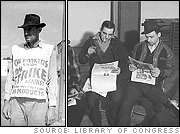Labor Day in the United States

Work in America: History, Facts, Statistics, & Leaders

Labor Day celebrations: parties, picnics, and poolside afternoons are often associated with this three-day weekend and national holiday, as well as an impressive street parade put on throughout many US capitals and largest cities, from San Francisco to New York City.
But the Labor Day weekend is important for so much more than being a day off! Read on for the History of Labor Day and some quick facts about its origins, economic impacts, and US labor statistics.
What Is Labor Day and Why Do We Celebrate It?
Labor Day is more than just the unofficial end of summer, going back to school, and a good opportunity to squeeze in some last barbecues with friends and family. The holiday of Labor Day functions as a commemoration for exactly what it sounds like— the social and economic accomplishments of laborers worldwide to improve working conditions.
Thanks to the early American workers and activists in the labor movement in the nineteenth century, this federal holiday was proposed in 1882 and the first Labor Day parade was held on September 5th of that year, with President Grover Cleveland signing it into an annual law for the first Monday of September in 1894.
Why Is It Called Labor Day?
The name “Labor Day” refers primarily to the balance of work and life that early labor movement protestors in the 1800s strove for: instead of unregulated hours and horrendous working conditions, international workers’ advocates championed an even split of labor.
This eventually led to the 8-hour day movement, including 8 hours for work, 8 hours for rest, and 8 hours for personal enjoyment, completing a full 24-hour period.
What Is the Difference Between Labour Day and Labor Day?
Labour Day is also celebrated in Canada, with the spelling utilizing British English, as opposed to the American English spelling of “labor”. However, both annual public holiday dates fall on September 5th, or the first Monday of September, regardless of the country!
Labor Day History & Statistics
The Labor Day holiday as we know it grew out of the efforts of labor unions over a century ago. According to the U.S. Department of Labor, records indicate the holiday was first proposed in the late 19th century.
Two men are credited with the original idea: Peter J. McGuire, a co-founder of the American Federation of Labor, and Matthew Maguire, a machinist and secretary of the Central Labor Union in New York. Below, you can find details about various economic impacts, employment numbers, and US labor information
Earnings
- Median Income of Households
- Household Income by Race
- Per Capita Personal Income
- More on... Poverty and Income
- Occupations with the Highest Earnings
- Occupations with the Lowest Earnings
- Federal Minimum Wage Rates
- Median Four-Person Family Income
- More on... Labor and Employment
- Earnings by Educational Attainment
- More on... Education
Employment and Wages
- State Unemployment Compensation
- Federal Minimum Wage Rates
- State Minimum Wage Rates
- 10 Occupations with the Highest Median Earnings
- Occupations with Highest Median Weekly Earnings Among Women
- Fastest Growing Occupations
- Industries with the Fastest Wage and Salary Employment Growth
- Labor Force Diversity
- Persons in the Labor Force
- Youth Employment Trends
- Youth Employment Status
- Youth Employers
- More on... Labor and Employment
- Equal Employment Opportunity Commission
- Employment Status of Persons with Disabilities
- Leading Occupations of Employed Women
- Mothers Participating in Labor Force
Labor Unions
About the author








